Cutting a clean slice 107 feet deep into the Chickamauga Dam may sound like a bad idea. But the unusual and complex project is actually essential maintenance, said Daniel Moore, a civil engineer for TVA.
"We're creating a space for the concrete to grow," Moore said on a tour Friday. "The whole length of the dam is continuing to grow."
This is the third time the dam has been sliced. The first cut came in 1997, when the dam was 57 years old. Crews cut again in 2008, and the latest effort should be wrapped up in February, Moore said.
Laboring on the deck of the dam just below Highway 153, crews are slicing a slot about 5/8ths of an inch wide in the dam to give the concrete some breathing room. The material expands slowly over the years because of a phenomenon called alkali-aggregate reaction. As the concrete expands, the moving parts of the dam lose the clearance they need to function for flood control and hydroelectric generation.
The crews of five to six people follow the same cutlines from the two previous projects to slice the dam, re-cutting the slot that had closed up over the years. The cut starts on the deck of the dam, where it's 38 feet wide, and goes 107 feet deep, where the dam is about 80 feet wide, stopping just short of the foundation. Crews will put a seal in the dam after the slot cut is completed in early 2021.
Dam facts
The Chickamauga Dam is 129 feet high and stretches 5,800 feet across the Tennessee River.TVA operates river dams at 49 sites, 29 of which generate hydroelectric power.TVA has invested more than $400 million in dam safety projects since 2010.
The project takes about three months, and someone has to be on the dam 24 hours a day, seven days a week while the saws are running. Otherwise, they are out there regardless of weather - with one exception.
"We stop for lightning. That's it," Moore said.
The work needs to be done in the cold months because the concrete expands more in the heat of the summer, creating pressure. To make the cut, crews use a diamond wire saw, which is a steel cable with 15-millimeter diamond beads in it. The cable is run through a series of motorized pulleys that operate like a giant bandsaw, slicing by degrees through the concrete.
There are three dams in the TVA system susceptible to concrete expansion: Chickamauga, Hiwassee and Fontana, Moore said. The alkali-aggregate reaction phenomenon is fairly rare, and is caused by a combination of water and materials that are susceptible to expansion, he said.
In the 1930s, when workers dug the rock out of the quarry off nearby Hamill Road to build the Chickamauga Dam, they didn't know that rock would expand, Moore said.
"It was all built before we really knew what alkali-aggregate reaction was," Moore said. "With newer dams, they can take precautions."
The Chickamauga Dam was completed in 1940 and, over the years, engineers slowly began to notice problems with tighter clearances and smaller air gaps in the dam. Now, instruments constantly monitor how much the dam is expanding, and the cut needs to be repeated every six to 12 years, Moore said.
"We have hundreds of instruments up here monitoring so we have an idea what the stress on the concrete is," he said.
Workers slice the dam in three phases - first the downstream side, then the upstream side, then they connect those cuts by slicing the middle. Some of the cutting occurs below the water line, and divers have to go under the surface to set the pulleys that drive the saws, Moore said.
Kristen Smith, senior program manager for dam safety, said the project takes an experienced crew.
"It's pretty specialized work we're doing," she said.
Contact Mary Fortune at mfortune@timesfreepress.com. Follow her on Twitter at @maryfortune.

